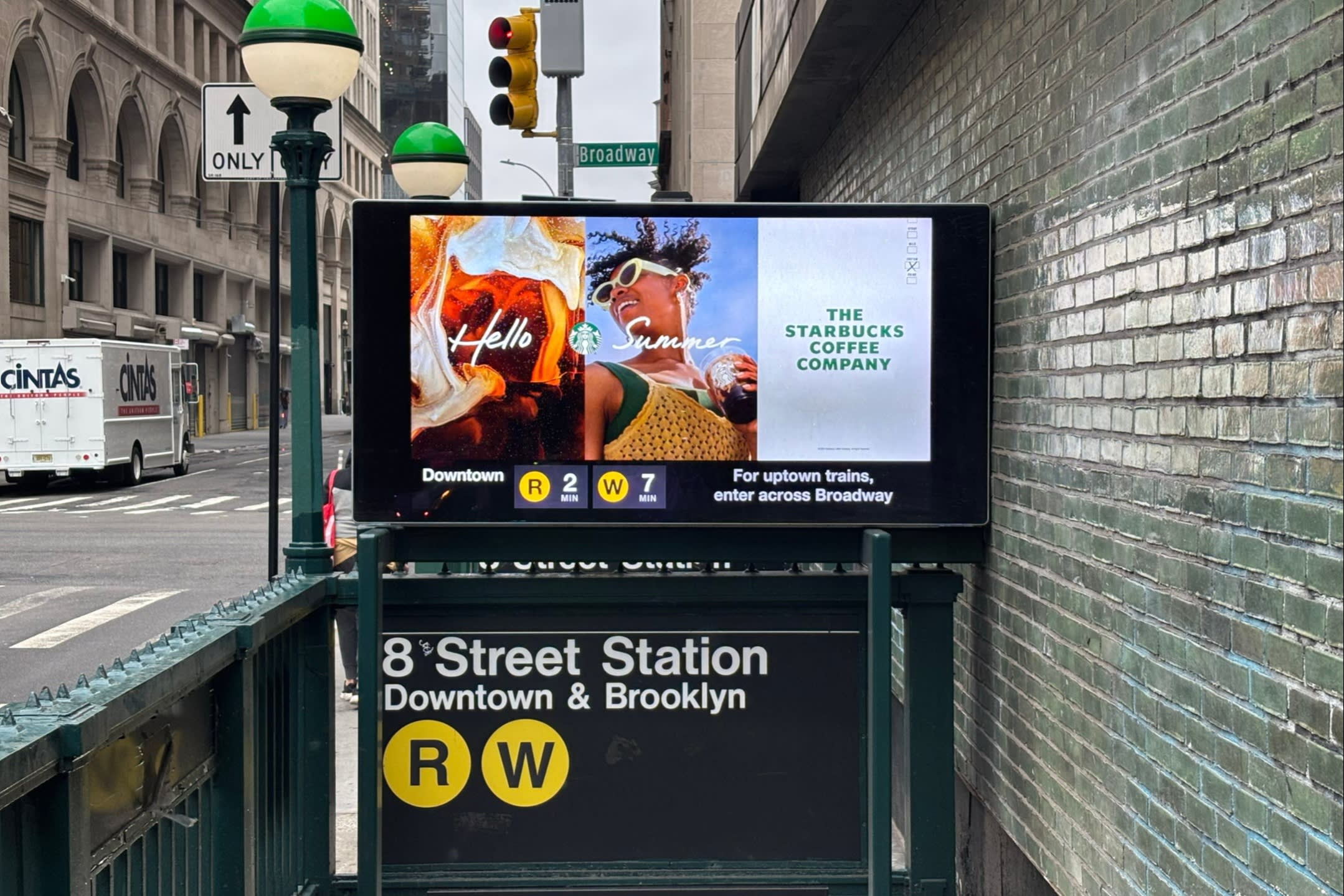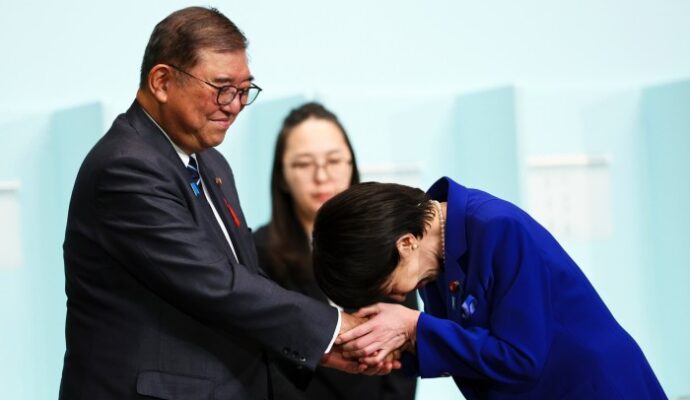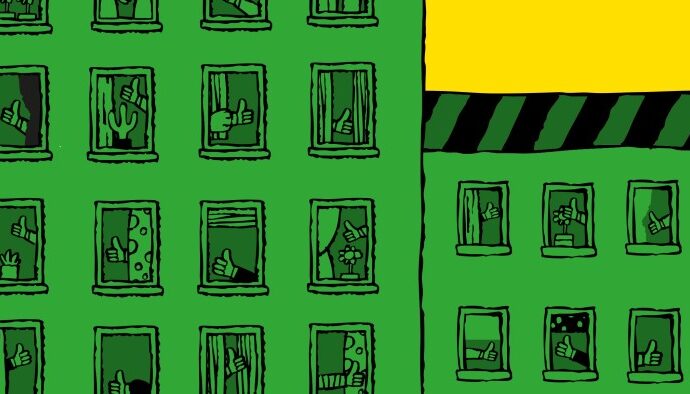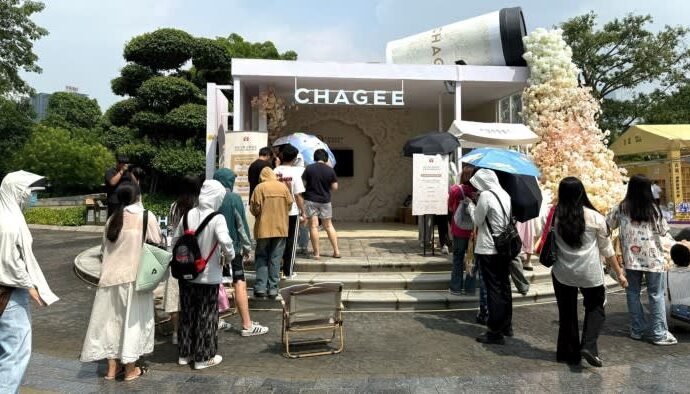Unlock the Editor’s Digest for free
Roula Khalaf, Editor of the FT, selects her favourite stories in this weekly newsletter.
Starbucks greeted the opening of a Luckin Coffee outlet in Manhattan by plastering the windows of a vacant store across the street with advertising, highlighting how seriously it is taking the threat from the Chinese competitor.
The front and side of the empty shop at 757 Broadway is covered with the Starbucks Coffee Company logo, glossy photos of a model and beverages, and the message “Hello Summer”. A Starbucks advert flashes on video screens above a subway train exit next to Luckin’s exterior brick wall.
Starbucks’ marketing campaign cannot be avoided by customers entering the Luckin shop at 755 Broadway, one of two Manhattan stores that opened in June as part of the company’s entry into the US market. More will open in August, a store employee told the Financial Times.
Luckin overtook Starbucks as China’s largest coffee chain by both store count and revenue two years ago, capitalising on a slowing economy that pushed consumers towards lower-cost alternatives. It operates more than 26,000 stores, the vast majority in mainland China. Starbucks has more than 41,000 stores worldwide, with about 7,800 Chinese outlets.
The Xiamen-based company is now seeking to repeat its success on Starbucks’ home turf — with a very different operating model.
Luckin requires customers to order drinks through its app, which gathers a wealth of data on their consumption patterns and offers coupons and discounts for larger orders.
Unlike Starbucks, which last week reported its sixth consecutive quarter of declining same-store sale, the majority of Luckin’s stores in China lack seating. Its two stores in Manhattan feature sparse clusters of firm chairs and benches.
Mobile and app orders are an important, but not exclusive, source of business for Starbucks, accounting for 31 per cent of its US transactions.
Under chief executive Brian Niccol, the Seattle-based company is spending about $150,000 per store to remodel the decor and add more comfortable seats in an effort to restore its allure as a relaxing place to enjoy coffee and drinks with companions.
Henry Barklam, a software engineer who was returning to the Greenwich Village Luckin to take advantage of the deals, said he found neither outlet an appealing place to spend time.

“I used to go there [Starbucks] to work. Now there’s no way I’d go and sit in Starbucks. It’s rundown,” Barklam said.
Last week, Niccol announced that Starbucks would “sunset” between 80-90 mobile stores that were designed solely for picking up mobile orders, with no seating.
“We found this format to be overly transactional and lacking the warmth and human connection that defines our brand,” Niccol told analysts.
A Starbucks representative emphasised it would continue to serve all customers whether they ordered in person, at drive-through windows or on its app.
Foot traffic data gathered by Advan Research showed that Starbucks’ efforts to make stores more welcoming were having an impact: visits from customers who stayed for at least 30 minutes were up about 5 per cent year on year in the three months to June.
“The market is segmenting itself into two separate parts,” said Thomas Paulson, Advan’s head of market insights.
“There’s the highly transactional, app-based, don’t linger, grab-and-go segment. And there’s the other, where you are visiting the place to experience . . . the atmosphere. You’re choosing to linger in that space.”
Sidewalk signs outside Luckin’s two Manhattan stores displayed a QR code to download its app last week, touting $1.99 beverages for new customers.
Luckin’s Broadway store is a block from Astor Place, where two Starbucks cafés once stood 250 feet from each other before closing. Its other New York location on Sixth Avenue is half a block from a Starbucks that continues to operate.
Rachel Maxwell, a university student in New York for a summer internship, had just picked up an iced velvet latte from Luckin after downloading the app. She liked its approach.
“New York City is a very busy place. People always have places to go. So in some cases it’s nice to have a coffee shop that is not as personal,” she said.
Outside a mobile pick-up only Starbucks in Manhattan, policeman Julio Guadalupe greeted news of the “sunset” plans with dismay. The 46-year-old officer scorns sitting inside coffee houses, calling it “pretentious”.
“If you just want to go and grab your coffee, this is awesome,” he said of app-based coffee pick-ups. “100 per cent, it’s where this country is headed.”
A representative for Luckin’s US office did not respond to a request for comment. Starbucks said: “We’re doubling down on what customers have always loved about Starbucks — a warm and welcoming coffee house with high-quality beverages crafted by a skilled barista.”
Additional reporting by Eleanor Olcott in Beijing


